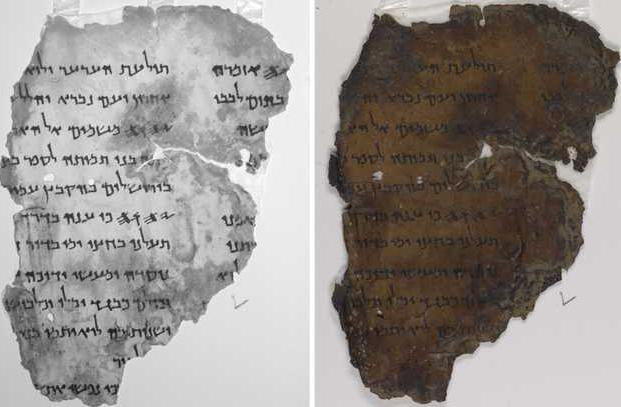JERUSALEM — Scientists using American space technology have started a huge project to digitally photograph the Dead Sea Scrolls, the oldest known version of the Hebrew Bible, and post it on the Internet for all to see, Israeli authorities said Wednesday.
High-tech cameras using infrared photography are being used to uncover sections of the 2,000-year-old scrolls that have faded over the centuries and become indecipherable, the Israeli Antiquities Authority said.
The project is expected to take about five years and the goal is to make the scrolls accessible to scientists and the general public, Antiquities Authority official Pnina Shor said.
‘‘Now for the first time the scrolls will be a computer click away,’’ said Shor, who heads the authority’s department responsible for the conservation of artifacts. ‘‘This will ensure that the scrolls are preserved for another 2,000 years.’’
Experts have complained for years that only a small number of scholars have been allowed access to the scrolls and the thousands of fragments that were found in caves near the Dead Sea in the late 1940s. In recent years, steps have been taken to widen access, but many of the findings are still not properly identified and categorized.
To protect the scrolls, Shor said, the new imaging will be done in a setting that minimizes exposure to light.
A pilot project started Wednesday and when it is finished, it will be possible to determine how long it will take to digitize the thousands of fragments from about 900 separate documents, Shor said, estimating five years.
The American space connection came through Greg Bearman, who recently retired as principal scientist for the NASA Jet Propulsion Laboratory. He offered the space-age imaging equipment.
‘‘I am an archaeology buff,’’ he told The Associated Press, and he brought imaging technology used in space to the Dead Sea Scrolls project. ‘‘This equipment is used to study planets,’’ he said. ‘‘NASA uses the technology for imaging in space, and it works here.’’
Infrared technology was used to photograph all the findings in 1950, the Antiquities Authority said, but technology has advanced considerably since then.
The first scrolls were discovered by accident in 1947 by a young Bedouin shepherd who was chasing a runaway sheep. They were buried in a cave in Qumran, just above the Dead Sea — one of the most barren areas in the world.
Archaeologists began buying scrolls and fragments that appeared in marketplaces around the region, but many were damaged by their removal from the extreme dryness of the cave where they were buried for 20 centuries.
Occasionally, the Antiquities Authority, which is in charge of preserving the scrolls, allows the public to see some of them. A 24-foot section with the Book of Isaiah went on display in May to coincide with Israel’s 60th anniversary celebrations.
A special hall called the Shrine of the Book at the Israel Museum in Jerusalem is dedicated to the scrolls, but the fragments on display there are copies.
High-tech cameras using infrared photography are being used to uncover sections of the 2,000-year-old scrolls that have faded over the centuries and become indecipherable, the Israeli Antiquities Authority said.
The project is expected to take about five years and the goal is to make the scrolls accessible to scientists and the general public, Antiquities Authority official Pnina Shor said.
‘‘Now for the first time the scrolls will be a computer click away,’’ said Shor, who heads the authority’s department responsible for the conservation of artifacts. ‘‘This will ensure that the scrolls are preserved for another 2,000 years.’’
Experts have complained for years that only a small number of scholars have been allowed access to the scrolls and the thousands of fragments that were found in caves near the Dead Sea in the late 1940s. In recent years, steps have been taken to widen access, but many of the findings are still not properly identified and categorized.
To protect the scrolls, Shor said, the new imaging will be done in a setting that minimizes exposure to light.
A pilot project started Wednesday and when it is finished, it will be possible to determine how long it will take to digitize the thousands of fragments from about 900 separate documents, Shor said, estimating five years.
The American space connection came through Greg Bearman, who recently retired as principal scientist for the NASA Jet Propulsion Laboratory. He offered the space-age imaging equipment.
‘‘I am an archaeology buff,’’ he told The Associated Press, and he brought imaging technology used in space to the Dead Sea Scrolls project. ‘‘This equipment is used to study planets,’’ he said. ‘‘NASA uses the technology for imaging in space, and it works here.’’
Infrared technology was used to photograph all the findings in 1950, the Antiquities Authority said, but technology has advanced considerably since then.
The first scrolls were discovered by accident in 1947 by a young Bedouin shepherd who was chasing a runaway sheep. They were buried in a cave in Qumran, just above the Dead Sea — one of the most barren areas in the world.
Archaeologists began buying scrolls and fragments that appeared in marketplaces around the region, but many were damaged by their removal from the extreme dryness of the cave where they were buried for 20 centuries.
Occasionally, the Antiquities Authority, which is in charge of preserving the scrolls, allows the public to see some of them. A 24-foot section with the Book of Isaiah went on display in May to coincide with Israel’s 60th anniversary celebrations.
A special hall called the Shrine of the Book at the Israel Museum in Jerusalem is dedicated to the scrolls, but the fragments on display there are copies.

